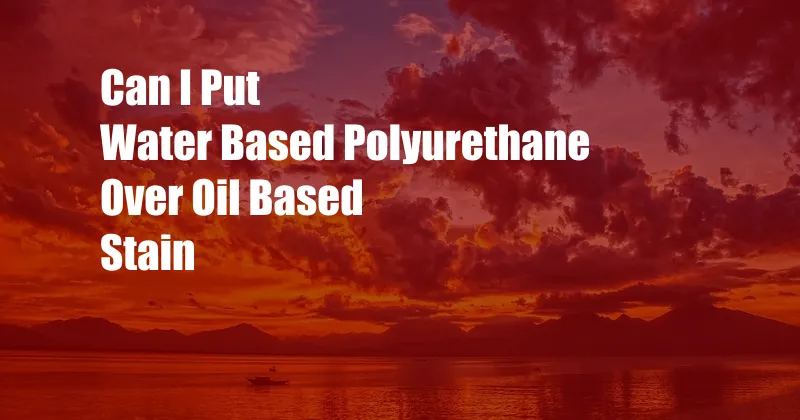
Can I Put Water-Based Polyurethane Over Oil-Based Stain?
As an avid DIY enthusiast, I’ve faced my fair share of conundrums, including the perplexing question of whether it’s feasible to apply water-based polyurethane over oil-based stain. In my quest to refinish an old wooden table, I stumbled upon this dilemma and embarked on a journey to unravel the intricacies behind this seemingly straightforward task.
To shed light on this topic, let’s delve into the fundamental differences between these two types of finishes. Oil-based stains penetrate deep into the wood’s pores, imparting rich color and enhancing its natural grain. In contrast, water-based stains form a film on the surface, offering less absorption and a more opaque appearance. The key distinction lies in their solvents: oil-based stains utilize mineral spirits or paint thinners, whereas water-based stains employ water.
Understanding Compatibility Issues
The compatibility of water-based polyurethane over oil-based stain revolves around the fundamental principle of “like dissolves like.” Since water-based polyurethane contains water as its solvent, it may not adhere well to an oil-based stain. The water molecules in the polyurethane can interact with the oil molecules in the stain, causing the finish to bubble, peel, or discolor over time.
Moreover, water-based polyurethane dries quickly, forming a hard film that may not allow the oil-based stain to fully cure. This can lead to premature wear and tear, compromising the longevity and aesthetic appeal of the finished surface.
Prepping the Surface for Water-Based Polyurethane
If you’re determined to apply water-based polyurethane over oil-based stain, it’s crucial to prepare the surface thoroughly to minimize compatibility issues. Here’s a step-by-step guide:
- Clean the Surface: Remove all dirt, dust, and grime from the surface using a mild detergent and warm water. Allow it to dry completely.
- Sand the Surface: Lightly sand the surface with fine-grit sandpaper (220 or higher) to create a slightly roughened texture. This will help the polyurethane adhere better.
- Remove Sanding Dust: Vacuum or wipe away all sanding dust. Use a tack cloth to remove any remaining particles.
- Apply a Shellac Primer: Apply a thin coat of shellac primer using a brush or a spray gun. Shellac is an excellent barrier between oil-based stain and water-based polyurethane, improving adhesion and preventing compatibility problems.
Tips and Expert Advice
Here are a few additional tips and expert advice to ensure a successful application of water-based polyurethane over oil-based stain:
- Always perform a patch test on an inconspicuous area before applying the polyurethane to the entire surface.
- Apply thin, even coats of polyurethane, allowing each coat to dry completely before applying the next.
- Use a high-quality polyurethane specifically designed for wood surfaces.
- Allow ample drying time for the polyurethane to fully cure and reach its maximum durability.
By following these guidelines, you can increase the chances of achieving a seamless and durable finish when applying water-based polyurethane over oil-based stain.
Frequently Asked Questions
Q: Can I use oil-based polyurethane over water-based stain?
A: Yes, oil-based polyurethane can be applied over water-based stain without compatibility issues.
Q: Is it necessary to sand the surface before applying the polyurethane?
A: Yes, sanding the surface helps create a roughened texture for better adhesion.
Q: How many coats of polyurethane should I apply?
A: Typically, two to three thin coats are sufficient for most projects.
Q: How long should I wait for the polyurethane to dry before using the surface?
A: Allow ample drying time, usually overnight or as per the manufacturer’s instructions.
Conclusion
While it’s generally not advisable to apply water-based polyurethane directly over oil-based stain due to potential compatibility issues, it can be achieved with proper surface preparation and by following the guidelines outlined in this article. Remember, the key is to create a barrier between the two finishes to prevent adverse reactions. By adhering to these principles, you can confidently refinish your wooden surfaces with a durable and aesthetically pleasing finish.